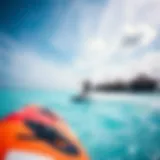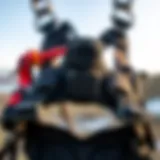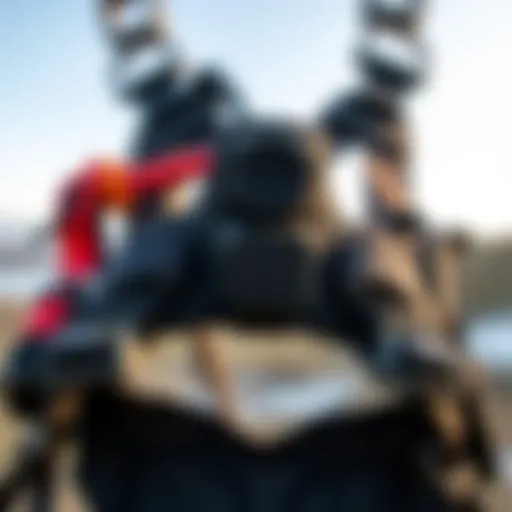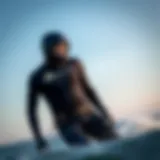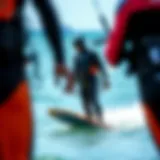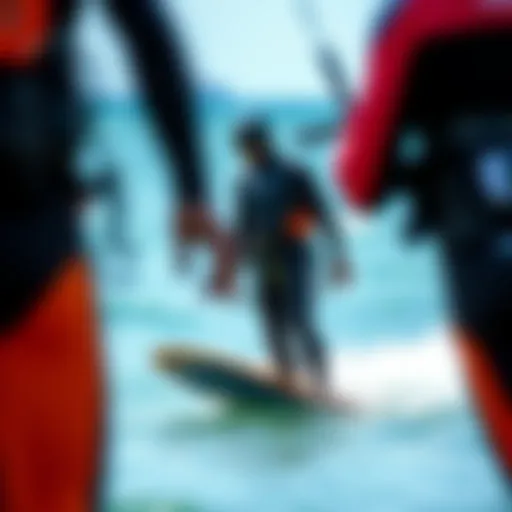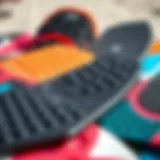Kiteboarding Adventures in Anguilla and St. Martin
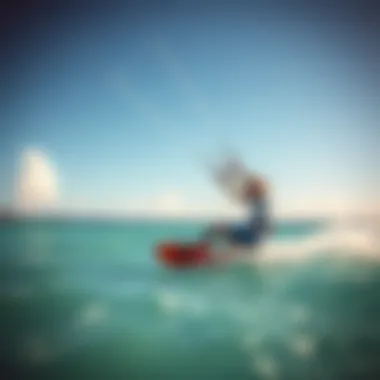

Intro
Kiteboarding has soared in popularity, taking adventures to the next level in places like Anguilla and St. Martin. Enthusiasts flock to these Caribbean jewels not just for their mesmerizing beaches, but also for their prime wind conditions and a vibrant culture that welcomes water sports aficionados. In this guide, we aim to delve into the nitty-gritty of kiteboarding in these two stunning locales, sharing valuable insights that cater to those from novice riders to seasoned pros.
As the wind whips through the air and the sun bathes the waters in golden hues, managing your gear and technique can turn a good day into an unforgettable one. We need to cover gear insights, exploring what’s hot on the market, and offering practical tips for beginners. We'll also tackle some advanced tricks for the more skilled kiteboarders, while placing a strong emphasis on safety practices.
In essence, this article is curated for those looking not just to kiteboard, but to become part of the community that defines Anguilla and St. Martin’s kiteboarding scene. So, tighten your harnesses and grab your boards; let's ride the wind together!
Gear Insights
Latest Gear Reviews
When it comes to kiteboarding, the right gear can help make or break your experience. The market's flooded with different types of kites, boards, and accessories, making it crucial to identify what works best for you. The North Kiteboarding Rebel consistently ranks high on many reviews, praised for its versatility and user-friendliness. It's great in a variety of wind conditions and provides a smooth ride, making it popular among both beginners and advanced kiteboarders.
Another noteworthy mention is the Liquid Force NV, which offers fantastic stability and control even in gusty conditions. This kite is ideal for those looking to perform tricks while still keeping their balance. While it may have a bit of a learning curve, riders often find that its performance is worth the effort.
Additionally, you can't overlook the importance of quality lines and harnesses. Brands like Mystic and Ion provide reliable options that not only enhance your performance but also ensure comfort when you're out on the water for extended periods.
Essential Gear for Beginners
For beginners venturing into kiteboarding, it can be a bit overwhelming to pick the right gear. However, there are essentials that will make the initial experience more enjoyable and safe.
- Kite: Start with a smaller, easy-to-handle kite. Most novices find that a 9-12 meter kite is manageable and allows them to practice without feeling overpowered.
- Board: A wider board gives more stability, perfect for first-timers tackling the waves. Look for options like the Slingshot Angry Swallow, designed for easier upwind riding.
- Safety Gear: Don't skimp on safety! A good-quality helmet and impact vest can protect you from unforeseen tumbles and bumps.
- Lessons: Consider enrolling in a local school. Learning through structured sessions can dramatically speed up your progression. Many schools in both Anguilla and St. Martin offer lessons and rentals, making it easy to dive right in.
"Kiteboarding isn’t just a sport; it's a community. Sharing tales on the beach after an exhilarating session creates bonds that last far beyond the ride."
Techniques and Tips
In kiteboarding, mastering various techniques can greatly enhance your overall experience. Tricks like jumps, spins, and flips can grow your skills exponentially, but they require practice and patience. For those looking to jump higher, focus on mastering your edging and timing with your kite's pull. This balance is critical in getting that lift to soar above the waves.
Advanced Tricks and Techniques
For the more experienced riders, tricks such as the KGB or the S-bend are fantastic ways to impress fellow kiteboarders. Both require good control of the kite, and ensuring a strong gust of wind helps in executing these tricks proficiently.
However, remember that every advancement brings risks; therefore, practicing these tricks in designated areas with clear space is advisable.
Safety Practices for Kiteboarders
Safety is paramount in kiteboarding, especially in the unpredictable conditions that can arise in Anguilla and St. Martin. Here are some practices to adhere to:
- Know Your Limits: If conditions seem risky, it’s better to stay on shore.
- Buddy System: Always kite with a partner when possible. Having someone nearby can make a big difference in case of an emergency.
- Pre-Sail Checks: Regularly inspect your gear for any wear or fray. Simple checks can prevent accidents.
- Weather Awareness: Be sure to check wind forecasts and local conditions. Resources like Windy or Windfinder can provide reliable updates.
As you explore kiteboarding, integrating these practices into your routine will not only improve your skills but also ensure a safer experience on these beautiful Caribbean waters.
Prologue to Kiteboarding in Anguilla and St. Martin
Kiteboarding has become a way of life for enthusiasts seeking both thrilling adventures and serene moments on water. As we hone in on Anguilla and St. Martin, it becomes evident that these islands are more than just tropical paradises; they are also hubs for kiteboarding activities that attract both seasoned pros and eager novices. In this article, we will explore what makes these Caribbean hotspots exceptional for kiteboarding, emphasizing various local conditions, equipment needs, cultural nuances, and travel tips.
Understanding the unique offerings in Anguilla and St. Martin allows kiteboarders to gain more than just an adrenaline rush—it also opens pathways for community engagement and environmental consideration. In other words, it's not just about catching the wind and riding the waves; it’s about connecting with the sea and the people around you. Here, we're diving deeper into essential factors including local wind patterns, safety measures, and the social aspects surrounding this dynamic sport.
In Anguilla, the flat waters and consistent wind create a welcoming environment for kiteboarders. Not far off, St. Martin presents its own distinct character, combining scenic backdrops with challenging conditions. For those ready to take the plunge, understanding the details, such as the best times to visit or appropriate gear selections, becomes crucial.
Whether you're a kiteboarder aiming to refine your skills or a newcomer wishing to dip your toes into this exhilarating sport, both islands offer diverse and enriching experiences. From gear recommendations tailored to your level of expertise to practical safety tips for navigating the waters, this guide aims to provide an in-depth look into the kiteboarding realm of Anguilla and St. Martin.
"The ocean stirs the heart, inspires the imagination, and brings eternal joy to the soul."
With an adventure waiting just around the corner, let's embark on this exploration of wind, water, and community. Prepare to push your boundaries and sail into the heart of kiteboarding in paradise.
The Kiteboarding Scene in Anguilla
The kiteboarding scene in Anguilla is more than just a water sport; it's a vibrant ecosystem that draws enthusiasts from around the globe. This island, known for its pristine beaches and turquoise waters, offers unique conditions that cater to kiteboarders of all skill levels. A combination of consistent winds, calm waters, and breathtaking landscapes makes Anguilla a premier kiteboarding destination. For those eager to embrace the thrill of gliding across the waves, understanding the local conditions and culture can be pivotal.
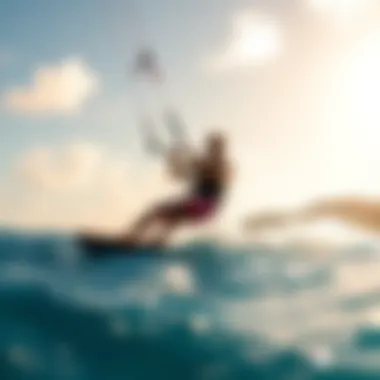
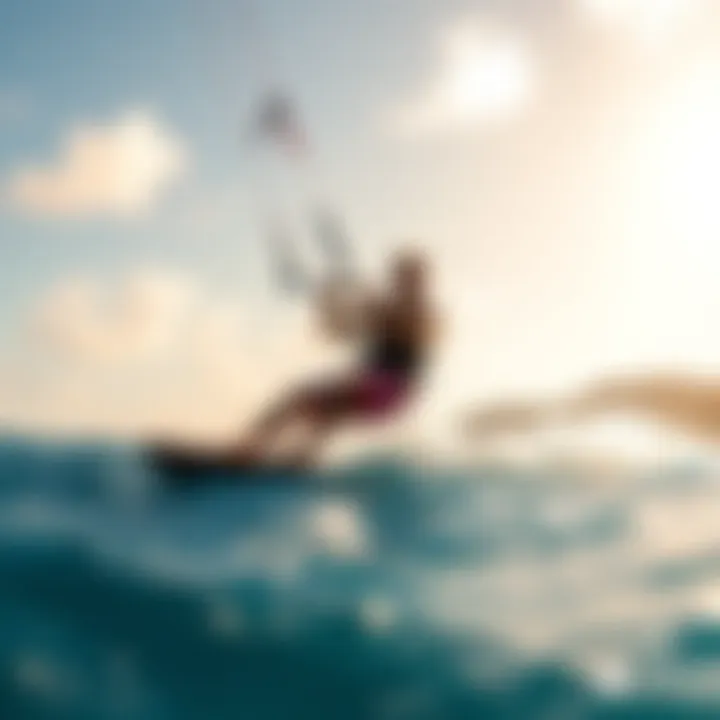
An Overview of Anguilla's Geography
Anguilla, a small, flat island located in the eastern Caribbean, measures about 16 miles long and 3 miles wide. Its geography is characterized by stunning white sandy beaches and shallow azure waters. This layout presents ideal conditions for kiteboarding. The island has several beaches that face directly into the prevailing winds, making it a hotspot for kiteboarding. The calm, shallow waters near the shore create a safe environment for beginners, while experienced riders can venture further out for more challenging conditions.
The unique geological features, such as reefs and sandbars, also contribute to the kiteboarding experience. These natural barriers create wind conditions that are favorable for the sport, ensuring that kiteboarders can enjoy excellent sessions nearly year-round.
Wind Patterns and Seasonal Considerations
Kiteboarding in Anguilla is highly dependent on wind patterns, and riders should pay careful attention to seasonal changes. The best time to visit for consistent wind is between December and July when trade winds blow steadily from the east. During this period, the winds can reach speeds of 15 to 25 knots, ideal for kiteboarding.
In the warmer months, especially in August and September, wind conditions can become fickle. Riders should check local forecasts regularly during these months as sudden storms can alter the landscape quickly. While the off-season may offer calmer winds, it also provides a tranquil experience, perfect for those who prefer less crowded water.
Best Kiteboarding Spots in Anguilla
Meads Bay
Meads Bay is often regarded as the flagship kiteboarding spot on the island. Its calm, shallow waters allow for exceptional visibility – beneficial for both beginners learning the ropes and experienced riders honing their skills. The beach runs for miles, which gives plenty of space to safely launch and land kites without interference. Moreover, the picturesque backdrop of luxury villas adds to the allure of this location, creating a perfect blend of sport and leisure. However, during peak tourist season, this spot can feel congested.
Shoal Bay
Shoal Bay, known for its stunning scenery, offers a different flavor for kiteboarders. It has a mix of waves and flat water that can accommodate both freestyle and wave riding. The presence of natural lunch spots and bars nearby makes it a great option for a full day of adventure. While the waters here can be slightly rougher than at Meads Bay, the excitement of riding waves can be an enticing challenge, especially for those seeking a more dynamic experience. Nevertheless, the wind can change unexpectedly, so riders should stay alert and monitor their surroundings.
Long Bay
Long Bay is particularly appealing for those looking to escape the bustling spots. This stretch of beach is less populated, offering a serene environment for kiteboarders. The shallow waters make it safe for newcomers, while the consistent winds provide ample opportunity for practice. Its relative isolation does come with less local amenities, meaning riders may need to bring their own equipment and refreshments. This adds a sense of adventure, but riders should always plan ahead to ensure they have everything needed for an enjoyable day on the water.
Safety Considerations for Riders
Understanding Local Conditions
Understanding local conditions is crucial for all kiteboarders, whether novice or seasoned. Every beach, including those in Anguilla, have their own unique microclimates affected by geographical features, tides, and wind patterns. Riders are strongly recommended to stick close to the local kiteboarding community and engage with instructors who can provide valuable insights into the local conditions. This knowledge can help prevent accidents and ensure a safer, more enjoyable experience.
Emergency Contacts
Having the right emergency contacts is essential for anyone engaging in water sports. Local rescue services or kiteboarding schools can provide immediate assistance if needed. Riders should familiarize themselves with local protocols and have important numbers readily available. Creating a safety plan with fellow riders can also be beneficial, as it helps establish a protocol for responding to emergencies. Having this awareness can not only enhance individual safety but also create a supportive environment among the kiteboarding community.
The Kiteboarding Experience in St. Martin
Kiteboarding in St. Martin offers a thrilling experience thanks to the perfect combination of wind, waves, and a vibrant local culture. This island, split between French and Dutch sides, presents a unique opportunity for enthusiasts, whether they are seasoned pros or beginners eager to learn. The diverse landscapes lend themselves to various riding styles, which makes it an attractive destination for kiteboarders. Moreover, understanding the local culture enhances the experience further, creating a connection between riders and the picturesque environment surrounding them.
Geographical and Cultural Overview
St. Martin is renowned for its breathtaking coastlines, serene lagoons, and a backdrop that includes mountains rolling into the sea. The island’s geography offers an abundance of kiteboarding spots. Travelers can find soft, sandy beaches facing the north coast, while the southern side offers more rugged terrain. This geographical variety not only provides excellent conditions for kiteboarding but also exposes riders to the rich blend of Caribbean and European cultures. The mix manifests in lively festivals, delectable cuisine, and a friendly, welcoming atmosphere.
Wind Patterns in St. Martin
The wind is the lifeblood of kiteboarding, and understanding the local wind patterns is crucial for a successful outing on the water.
Wind Directions
In St. Martin, the predominant wind directions generally range from the east-northeast. Riders often find that the east winds create excellent conditions, providing a steady and consistent breeze ideal for long, exhilarating runs. Because the winds tend to blow directly onto the beaches, this setup allows for more predictable conditions, making it favorable especially for novice riders. Plus, the noteworthy characteristic of the local wind patterns is their reliability, which gives kiteboarders peace of mind when planning their sessions.
Peak Seasons
The peak seasons for kiteboarding in St. Martin usually align with the trade winds, which blow most consistently from December to April. This period is deemed the best time for kiteboarding, as the reliable wind speeds average between 15 to 25 knots. With slightly cooler temperatures and lesser crowds than the summer months, kiteboarders are afforded the chance to show off their skills more freely. However, it’s essential to note that with peak seasons comes peak tourist activity, which may affect the accessibility of certain kiteboarding spots due to increased foot traffic.
Top Locations for Kiteboarding in St. Martin
St. Martin is dotted with some prime kiteboarding locations, each offering unique characteristics and ideal conditions.
Orient Bay
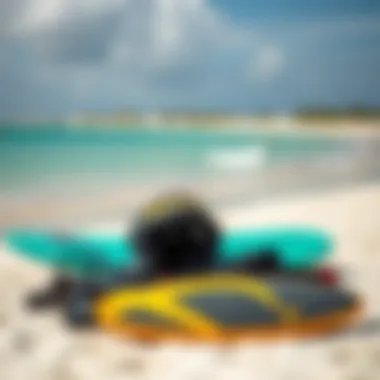
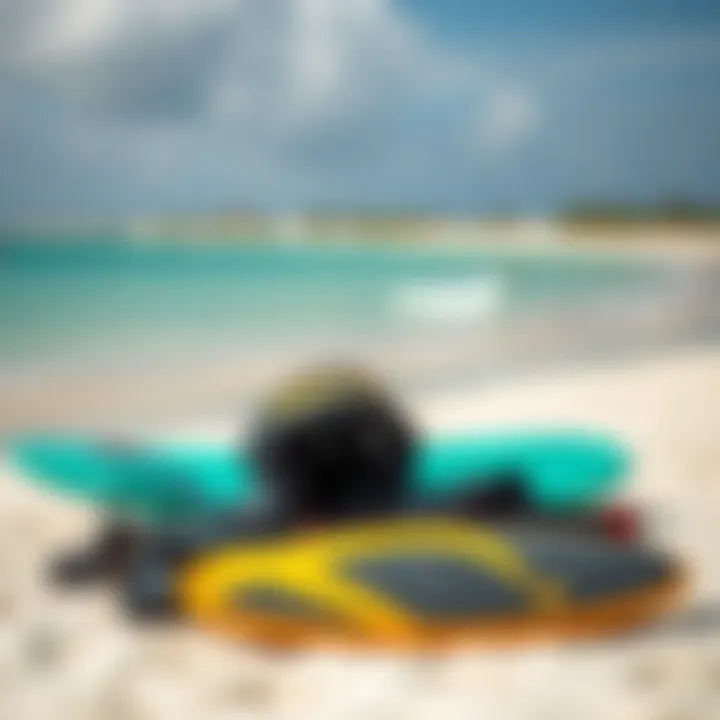
Probably the most famous kiteboarding site on the island, Orient Bay features a wide, spacious beach equipped with clear, shallow waters. This makes it an ideal learning ground as well as a playground for experienced riders. The prevailing winds here enhance the thrill, allowing for jumps and tricks without worrying too much about tides. That said, Orient Bay can get crowded, especially during peak season, making it wise to plan sessions during early hours or later in the afternoon.
Grand Case
Another noteworthy spot, Grand Case is famous for its serene ambiance and picturesque views. Traditionally a fishing village, the beach caters to both kite surfers and spectators alike. The shallow waters are welcoming to beginners but also provide enough room for experienced riders to perform. The unique advantage of Grand Case lies in the nearby restaurants and local shops that provide riders an opportunity to wind down after an exhilarating day on the water. However, one must remain cautious of the local fishing boats, which can occasionally infringe upon the riding area.
Mullet Bay
Known for its gentle winds and rolling waves, Mullet Bay offers a fantastic setting for both leisure and advanced kiteboarding. This spot has consistently favorable wind conditions that beckon riders. An advantage of Mullet Bay is its accessibility: it’s not only a hotspot for kite enthusiasts but also offers amenities and facilities nearby. One should be mindful that the entrance to the beach can get a bit tricky during high tide, making timings essential for safety and enjoyment.
Navigating Safety and Regulations
Safety is paramount in kiteboarding, and understanding the local laws and regulations is crucial for a responsible riding experience.
Local Laws for Kiteboarding
St. Martin, with its delicate marine ecosystems, has specific regulations concerning kiteboarding that riders should familiarize themselves with. Specific areas may designate no-kite zones, which typically prohibit kiteboarding to protect fragile environments or to ensure the safety of beachgoers. Abiding by these regulations is not just a legal matter; it reflects a respect for local culture and environmental stewardship. Therefore, checking with local authorities or kiteboarding schools provides clarity on the rules.
Preventative Safety Measures
Before hitting the water, kiteboarders should makes sure they are well-prepared with basic safety gear, such as life jackets, helmets, and personal flotation devices. Regular checking of equipment, and understanding the environmental situation can help prevent accidents. Additionally, it’s prudent for riders to notify someone of their plans, especially regarding locations and estimated time on the water. In short, ensuring personal safety enhances the experience, allowing individuals to fully savor the thrill without unnecessary stress.
Gear Recommendations for Kiteboarding
When it comes to kiteboarding, having the right gear is crucial for a fun and safe experience. Whether you are a newbie just getting your feet wet or a seasoned rider looking to push the limits, understanding what to equip yourself with can make all the difference. Kiteboarding gear isn't just about aesthetics; it enhances performance and ensures safety in various conditions. Here, we will break down the essentials for both beginners and seasoned riders, noting how each piece of equipment contributes to the overall experience.
Essential Equipment for Beginners
Kites
Kites are the heart of kiteboarding. They vary in size and design, tailored to different wind conditions and riding styles. A good beginner kite is usually larger, as this allows for more lift and easier control in light wind. This characteristic helps newbies find their balance on the board without being overpowered by strong gusts.
One unique aspect of beginner kites is their forgiving nature. Many models come with features that allow for better stability and easy relaunch from the water. However, a disadvantage might be that these kites can be slower to react compared to advanced designs, which can make them feel less exciting once you gain confidence. Nevertheless, they are a solid choice for anyone just starting.
Boards
The board is the second essential component for a kiteboarder. For beginners, wider boards are recommended, as they offer more stability and make it easier to ride comfortably. This key characteristic of beginner boards allows for a smoother transition onto the water and can enhance learning by making those first few rides less daunting.
An interesting feature of many beginner boards is their round edges, which reduce the chances of catching on waves. However, the downside is that these boards may not provide the same speed and maneuverability as more advanced, specialized options. Still, for a beginner, they serve as an excellent stepping stone.
Harnesses
Wearing a harness is essential for any kiteboarder, as it takes the strain off your arms and distributes the pull from the kite across your body. For beginners, a comfortable, well-fitted harness can make all the difference in enjoying your ride. Most beginner models are designed to be easy to put on and take off, often featuring soft padding for added comfort.
One unique aspect of harnesses is their various styles—including waist and seat harnesses. Waist harnesses are common among beginners for their ease of use and versatility. However, they may not offer as much support as seat harnesses, which might be beneficial for heavier riders or those who prefer a more secure feel. The trade-off is personal preference and riding style.
Advanced Gear for Experienced Riders
High-Performance Kites
For seasoned kiteboarders, high-performance kites are engineered for speed and agility. One key characteristic is their responsiveness; these kites are designed to react quickly to rider input, allowing for sharper turns and intense maneuvers. This is especially beneficial when riding in challenging conditions, as experienced riders can fully utilize the power of the wind.
A unique feature of high-performance kites is their use of specialized materials to reduce weight while maintaining durability. However, they often require a higher skill level to manage properly, presenting a disadvantage for those still refining their techniques. Overall, though they may have a steeper learning curve, the performance gains make them a worthwhile investment for serious kiteboarders.
Specialty Boards
Specialty boards cater to specific styles of kiteboarding, such as freestyle or wave riding. These boards come with unique designs meant to enhance performance in their respective fields. For example, freestyle boards are typically lighter and shorter, making them easier to spin and ollie.
The key characteristic of specialty boards lies in their tailored shapes, which offer improved handling and responsiveness. They can provide an exciting experience, pushing the boundaries of what riders can achieve. However, their design may sacrifice some versatility, making them less ideal for riders who enjoy exploring various styles. Understanding your personal riding preference is important when choosing this type of equipment.
"Investing in the right gear not only enhances your performance but also boosts your confidence as you ride the waves."
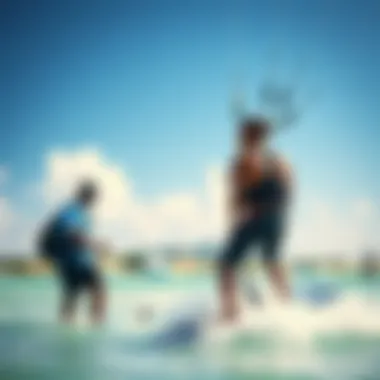
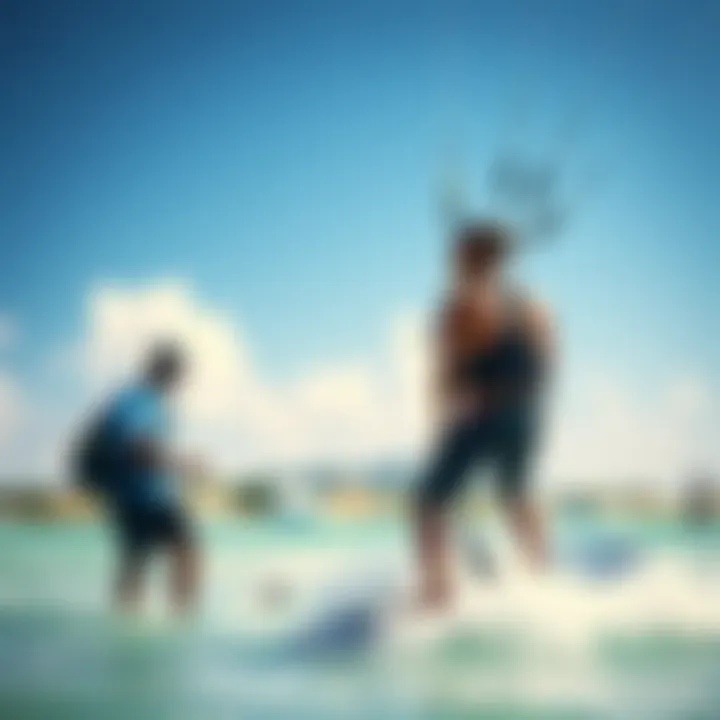
Local Culture and Community Impact
Exploring the world of kiteboarding in Anguilla and St. Martin is not just about the thrill of gliding over turquoise waters; it also reveals deep connections to local culture and communal engagement. Understanding the fabric of the communities in these islands enriches the kiteboarding experience, making it not only a sporting endeavor but a shared cultural journey. Here, we will dive into community ties and respect for local traditions in kiteboarding, highlighting their importance.
Community Engagement in Kiteboarding
Kiteboarding serves as a bridge between enthusiasts and the communities living on these Caribbean islands. Local kiteboarding schools and clubs play a pivotal role in fostering relationships among riders and residents. These organizations often host community events, such as cleanup days on beaches or kiteboarding competitions, that pull people together.
Moreover, engaging with the local kiteboarding community yields essential insights into the best spots and practices. Riders are encouraged to learn from seasoned locals, tapping into their wealth of knowledge about weather patterns, optimal riding conditions, and hidden gems away from the tourist trail. For instance, the kiteboarding hotspots like Meads Bay and Orient Bay are oftentimes discussed not just as perfect locations for action but as integral parts of the local social life.
Many riders who stay for an extended period often form friendships with local instructors who provide tailored lessons and guidance. This collaborative spirit reinforces bonds, showing how kiteboarding transcends sport and becomes part of a broader cultural exchange. Enthusiasts frequently share their own experiences and triumphs with locals, enriching the cultural tapestry of both visitors and residents.
Respecting Local Traditions
Respecting local customs and traditions is paramount for anyone wishing to enjoy kiteboarding in Anguilla and St. Martin. Beyond just riding the waves, there’s a need for riders to understand their role in preserving the local environment and culture. Recognizing the significance of customary practices can profoundly enhance one's experience on these islands.
For example, kiteboarders should be aware of the local ceremonies or festivals, which are often tied to the seasons. Participation in events like the Anguilla Summer Festival or St. Martin's Carnival creates a deeper connection and appreciation for the cultural heritage.
Additionally, riders should adopt the principle of "leave no trace." This approach aligns with respect for local ecology, thereby safeguarding the pristine settings that draw so many to the sport. Engaging with locals about protecting reefs and marine life is vital, especially as kiteboarding often takes place in sensitive areas.
In essence, understanding and respecting these local traditions not only protects the environment but builds lasting relationships with the island communities.
"Kiteboarding is more than a sport; it’s an opportunity to connect, learn, and grow within the vibrant cultures of Anguilla and St. Martin."
Travel Tips for Kiteboarders
Understanding the nuances of traveling for kiteboarding is crucial for ensuring a smooth and enjoyable experience. Whether you're a novice or a seasoned rider, knowing where to go, when to visit, and what to expect can significantly enhance your adventures in Anguilla and St. Martin. This section covers vital elements that kiteboarders should consider to make the most of their journey.
Best Times to Visit
Timing can make or break a kiteboarding trip. The Caribbean winds generally blow best between December and April, when trade winds are prevalent, creating ideal conditions for riding. During this period, the weather is also cooler and drier, making it comfortable for both kiteboarding and relaxation.
- Peak Season: December to April is the prime time. Expect ideal winds of 15 to 25 knots.
- Shoulder Season: November and May can also offer good wind, though conditions may vary.
- Consider Rainy Months: June to October is hurricane season; winds may be unstable.
Kiteboarders should keep an eye on local weather forecasts and be prepared for sudden changes. Checking reliable sources such as windfinder.com can provide up-to-date insights.
Logistics and Transportation
When traveling to Anguilla and St. Martin, your choice of transportation can significantly affect your overall experience. Here are aspects to think about:
- Flights: Most visitors land in Princess Juliana International Airport in St. Martin before taking a short ferry ride to Anguilla. Consider booking early, especially during peak season.
- Ferries: Regular ferry services run between St. Martin and Anguilla. The journey takes about 20 to 25 minutes and offers stunning views of the coastline.
- Rental Cars: Renting a vehicle on Anguilla is an excellent way to explore all the kiteboarding spots at your pace. Road conditions are usually good, and various rental agencies are available.
- Local Transportation: Taxis are plentiful, but they may not always serve remote beaches. It's best to plan ahead and confirm costs beforehand.
Accommodation Recommendations
Finding the right place to stay is as essential as knowing the best kiteboarding spots. Here are a few viable choices:
- Resort Options: For those preferring an all-inclusive experience, resorts like Malliouhana, An Auberge Resort in Anguilla offer luxurious amenities and direct beach access.
- Boutique Hotels: Le Petit Hotel in St. Martin offers a cozy atmosphere with kiteboarding accessibility.
- Airbnbs and Vacation Rentals: These can provide a more home-like environment, often located close to popular kiteboarding areas at a reasonable price.
When selecting your accommodation, consider factors such as proximity to kiteboarding spots, available amenities, and the overall vibe of the location. Readers are encouraged to check platforms like tripadvisor.com for reviews before making a reservation.
"An informed kiteboarder is a happy kiteboarder! Knowing when and where to go can elevate your riding experience to new heights."
Make the most of your kiteboarding trip by taking heed of these travel tips, ensuring your time spent in Anguilla and St. Martin is as thrilling and satisfying as the ride itself.
Ending
In summing up the thrill and adventure surrounding kiteboarding in Anguilla and St. Martin, it is evident that these Caribbean havens offer more than just picturesque scenery. The kiteboarding experience here is truly unique, shaped by the harmonious blend of natural elements, local culture, and a spirited community. For enthusiasts, whether they are seasoned pros or eager beginners, the insights presented throughout this article can significantly enhance their adventures.
Understanding local wind patterns and seasonal variations helps kiteboarders make informed choices. It's important to choose the right time to hit the waves, avoiding peak tourist flux while ensuring optimal wind conditions. This isn't just a minor detail; it can make a world of difference in one's kiteboarding experience. The top spots—be it the serene Meads Bay in Anguilla or the lively Orient Bay in St. Martin—provide varied landscapes suited to different styles and skill levels, keeping the experience fresh and exciting.
Additionally, safely navigating these waters is paramount. Riders must be educated about both local safety regulations and natural conditions unique to the islands. Emergencies can happen, and being prepared with knowing emergency contacts or guidelines can mitigate risk and foster a more enjoyable expedition. Respecting these elements ensures a pleasant relationship not just with the sea but also with the local community.
As our exploration of the kiteboarding scene wraps up, travel tips come into play, enhancing the adventure further. Whether that means finding the ideal accommodations or understanding the logistics of getting around, these elements intertwine with the kiteboarding experience, making the trip smoother and more enjoyable.
Ultimately, the shared passion for kiteboarding fosters connections among riders while also weaving them into the local culture. As each kite soars high against the azure sky, it signifies not just personal achievement but a collective camaraderie that transcends borders. Inspired kiteboarders and travelers alike can leave these islands with not just skill but with rich memories and stories to share.
Kiteboarding in Anguilla and St. Martin stands as a testament to adventure, excitement, and community, urging all who partake to embrace the winds and into the craft with open hearts.
